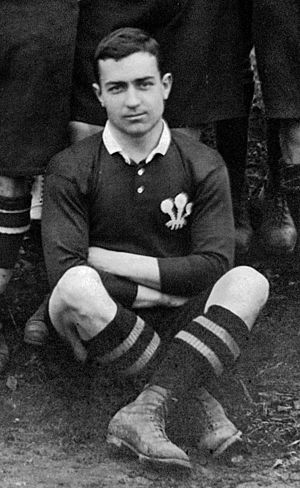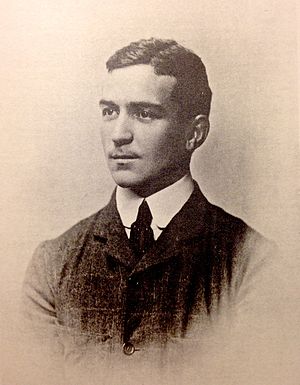Lou Phillips facts for kids

Phillips in 1900
|
|||||||||||||||||||||||||||||
| Birth name | Louis Augustus Phillips | ||||||||||||||||||||||||||||
|---|---|---|---|---|---|---|---|---|---|---|---|---|---|---|---|---|---|---|---|---|---|---|---|---|---|---|---|---|---|
| Date of birth | 24 February 1878 | ||||||||||||||||||||||||||||
| Place of birth | Newport, Monmouthshire, Wales | ||||||||||||||||||||||||||||
| Date of death | 14 March 1916 (aged 38) | ||||||||||||||||||||||||||||
| Place of death | Cambrin, France | ||||||||||||||||||||||||||||
| Height | 5 ft 6 in (1.68 m) | ||||||||||||||||||||||||||||
| Weight | 11 st (70 kg) | ||||||||||||||||||||||||||||
| School | Monmouth School | ||||||||||||||||||||||||||||
| Occupation(s) | Architect | ||||||||||||||||||||||||||||
| Rugby union career | |||||||||||||||||||||||||||||
|
|||||||||||||||||||||||||||||
| ---- | |||||||||||||||||||||||||||||
| Military career | |||||||||||||||||||||||||||||
| Allegiance | |||||||||||||||||||||||||||||
| Service/ |
|||||||||||||||||||||||||||||
| Years of service | 1914–1916 | ||||||||||||||||||||||||||||
| Rank | Sergeant | ||||||||||||||||||||||||||||
| Unit | Royal Fusiliers | ||||||||||||||||||||||||||||
Louis Augustus "Lou" Phillips (born 24 February 1878 – died 14 March 1916) was a talented Welsh rugby player. He played as a half-back for Newport RFC. Lou also played four times for the Wales national team. Besides rugby, he was a very good amateur golfer.
Lou Phillips was born in Newport, Wales. He went to Monmouth Grammar School. After school, he became an architect. He started playing rugby at school. Later, he joined Newport RFC. He became a key player for the team.
Phillips played 90 games for Newport. He formed a famous partnership with another half-back, Llewellyn Lloyd. His first game for Wales was in 1900. He played alongside Lloyd against England. Wales won that game and the Triple Crown. He played for Wales again in 1901. But he had to stop playing rugby because of an injury.
When the First World War started, Phillips joined the army. He became a Sergeant in the Royal Fusiliers. He went to France in November 1915. Sadly, he was killed in action on 14 March 1916. He was shot while on a dangerous mission near Cambrin, France.
Contents
Early Life and Career
Louis Augustus Phillips was born in Newport, Monmouthshire. This was on 24 February 1878. He went to Monmouth Grammar School for his education. After school, he trained to be an architect. He started his own architecture practice in 1907.
Rugby Adventures
Phillips started playing rugby at Monmouth Grammar School. He then joined the Newport RFC first team in 1897. His first season was a bit tough for the club. They lost more games than usual. Many players had left or retired. But Phillips was one of the new players who made a big difference. Other new stars included George Boots and Jehoida Hodges.
Teamwork with Llewellyn Lloyd
From 1897 to 1901, Phillips played with Llewellyn Lloyd. They formed a very strong half-back team at Newport. People saw them as a perfect pair. They both shared the jobs of scrum-half and outside-half. Lloyd was a faster runner. Phillips was better at kicking the ball. Both could score drop goals. They were also great at kicking the ball out of play.
In the 1898–99 season, Newport lost more players. Phillips and Boots were the only two players to play in all 24 matches. The next season, 1899–1900, was much better. Lloyd became captain. The team scored many more points. Phillips and Lloyd were seen as the best half-back pair. They were great for both their club and the national team. Phillips played 90 games for Newport in total. He scored 9 tries, 2 drop goals, and 1 penalty.
Playing for Wales
Phillips was a strong runner and a good tackler. He played his first international game for Wales on 6 January 1900. This was against England in Gloucester. He was chosen mainly because of his strong partnership with Lloyd at Newport. Lloyd also played for Wales in this game. Wales won the match 13–3. Phillips played very well in his first international game. He was a "splendid defender." He was thought to be one of the best players on the field.
In the next game, Wales played Scotland on 27 January. This game was in Swansea. Phillips and Lloyd continued to play well together. Their defense was strong. Phillips was great at catching the ball and kicking it out of play. Lloyd was clever and good at dodging players. Wales won again, 12–3. For the next game, against Ireland, Lloyd was replaced. Wales still won 3–0. This victory meant Wales won the Triple Crown.
Phillips missed the first game of the 1901 season. He had a knee injury. He tried to play in the next game against Scotland. But he was injured again early in the match. He kept playing, but it was a tough end to his short career. Scotland won the game 18–8.
International Games Played
Lou Phillips played in these international matches for Wales:
| Opposition | Score | Result | Date | Venue | Ref(s) |
|---|---|---|---|---|---|
| 3–13 | Won | 6 January 1900 | Gloucester | ||
| 12–3 | Won | 27 January 1900 | Swansea | ||
| 0–3 | Won | 17 March 1900 | Belfast | ||
| 18–8 | Lost | 9 February 1901 | Inverleith |
Golf Achievements
Lou Phillips was also a very good golfer. He won the Welsh Amateur golf championship twice. He won in 1907 and again in 1912. In 1913, he was second in the Irish Amateur Open Championship. The next year, 1914, he played well in The Amateur Championship. He also played for the Wales golf team against Ireland in August 1913.
Military Service and Death
When the First World War began, Phillips joined the army. He joined the 20th (Service) Battalion Royal Fusiliers. He chose to serve as a Sergeant. This battalion was made up of men from public schools and universities. Phillips was sent to France on 16 November 1915.
On the night of 14 March 1916, he was on a dangerous mission. This mission was called a wiring party. During this, he was shot in the chest and died. This happened near Cambrin, France. He is buried in the Cambrin Churchyard Extension.
Images for kids




